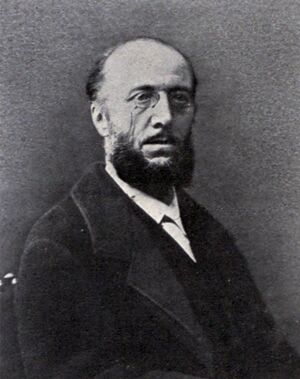پيير-ماري-ألكسي ميارديه
Pierre-Marie-Alexis Millardet | |
|---|---|
 Pierre-Marie-Alexis Millardet | |
| وُلِدَ | 13 December 1838 |
| توفي | 15 December 1902 (عن عمر 64) |
| القومية | French |
| المدرسة الأم | Heidelberg Freiberg |
| عـُرِف بـ | Phylloxera |
| الجوائز | 1893 Prix Morogues[1][2] |
| السيرة العلمية | |
| المجالات | botany and mycology |
| الهيئات | Strasbourg |
Pierre-Marie-Alexis Millardet (13 December 1838 – 15 December 1902) was a French botanist and mycologist born in Montmirey-la-Ville.
He was a student at the Universities of Heidelberg and Freiberg, and later became a professor of botany at the Universities of Strasbourg (1869), Nancy (1872), and Bordeaux (1876). Millardet is chiefly remembered for his work dealing with plant pests. In the 1860s the vineyards of France were infested by the destructive Phylloxera, an aphid-like pest inadvertently introduced to Europe from the United States. Millardet and fellow botanist Jules Émile Planchon (1823-1888) controlled the infestation by using American grape vines that were resistant to Phylloxera as grafting stock. American horticulturalist, T.V. Munson, was instrumental in identifying and provisioning the American rootstock that was resistant to Phylloxera and suitable for French growing conditions.
He was also responsible for protecting grape vineyards from downy mildew fungus (Plasmopara viticola). He accomplished this feat by implementing a fungicide consisting of hydrated lime, copper sulfate and water, a mixture that was to become known as the "Bordeaux mixture". It was the first fungicide to be used worldwide and is still used today.
and also saved the vineyards of France from destruction by the greenish yellow grape phylloxera, an aphidlike plant pest introduced into Europe on vines imported from the United States for grafting (1858-63). The insect swiftly spread extensive destruction. Millardet controlled this plague with resistant American vines as grafting stock, but these brought in the downy mildew fungus. In Oct 1882, he saw chemicals used by farmers for other reasons (a mixture of copper sulfate, lime and water) and after three years of testing, he found it acted as a suitable fungicide for the mildew. Known as the Bordeaux mixture, was the first fungicide to receive large-scale use the world over.
كتابات
- Monographie sur la croissance de la vigne et la technique d'hybridation artificielle. - Monograph on vine growth and artificial hybridization technique.
- Un porte-greffe pour les terrains crayeux et marneux les plus chlorosant. - Rootstock for chalky terrain and marl for chlorosis.
- Notes sur les vignes américaines et opuscules divers sur le même sujet. - Notes on American vines and various pamphlets on the same subject.
- Pourridié et Phylloxéra. Etude comparative de ces deux maladies de la vigne, 1882 - Phylloxera and rot. Comparative study of these two diseases of the vine.
- Histoire des principales variétés et espèces de vignes d'origine américaine qui résistent au phylloxera, (1885) - History of the main varieties and species of American grapes that are resistant to phylloxera.
المصادر
- This article is based on a translation of equivalent articles from the French and German Wikipedia.
- Dixon, Bernard (Sep 2004). "Pushing Bordeaux mixture". The Lancet Infectious Diseases. United States. 4 (9): 594. doi:10.1016/S1473-3099(04)01136-3. ISSN 1473-3099. PMID 15336227.
- ^ (France), Académie des Sciences (1894). "Tableaux des prix décernés". Comptes rendus hebdomadaires des séances de l'Académie des sciences. Vol. 117. p. 1007. (The French Academy awarded the 1893 prizes on 18 December 1893.)
- ^ "Science Prizes". American Naturalist. Vol. 28. U. of Chicago Press. 1894. p. 290.